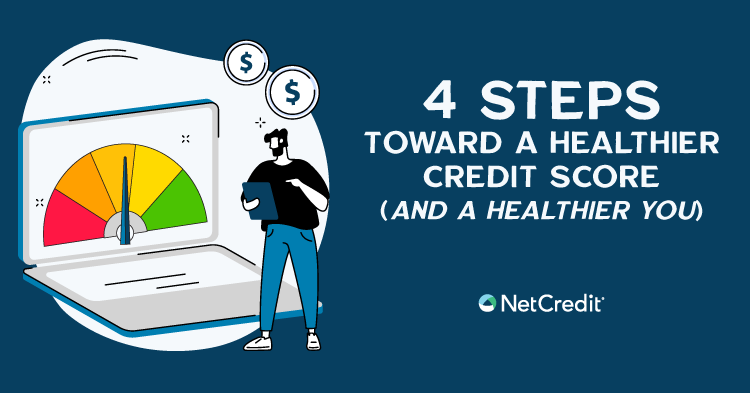Spring 2021 is here! This is the perfect time for a fresh start. Thanks to last year’s pandemic, the spring homebuying season has started earlier than usual. Coupled with an extended tax season and a fresh round of stimulus checks, many Americans are looking for more responsible ways to improve their well-being, both financially and physically.
A financially healthier you starts with your lifestyle and the decisions you make on a daily basis. Keep in mind that your habits impact your spending and your budget. In this guide we will show you how improving your credit health and your personal health go hand-in-hand.
Here are four steps to get you started on your path to financial and bodily wellness.
Create Goals for Your Finances (And Your Body)
The first step to financial wellness is to set some goals for yourself. In order to do this, you will have to do something you are probably dreading: checking your credit score. Don’t stress too much about where your credit is right now because you’re taking the strides toward a brighter financial future. Use your current credit score as a baseline for building an improved one.
The same holds true for your physical health: you have to see where your starting point is. As dreadful as it can be to look at the scale, this step is important to give you a base number to work from. Once you have your target weight and target credit score figured out, keep track of these numbers in a book or on your mobile device. While you don’t want to constantly look at these current numbers, having a record will help you keep those goals in sight. Every little step you take on this journey will get you closer to your endgame.
Watch Your Daily Spending (And Calories)
Now let’s take a look at your monthly budget. What do you make each month? How much do you spend? Sticking to your monthly budget starts with the day-to-day. Frivolous spending can create a huge dent in your bank account, leaving you with less than you thought you had. Try using a free service to help you find local and trusted resources in your area. Take advantage of the assistance in tracking your spending, monitoring debt, and budgeting as you work toward your goals. Additionally, make sure everyone in your household is on the same page. Do your children have specific, school-related expenses? Are you budgeting for that anniversary trip you promised your spouse? Take it a day, and a dollar, at a time.
Your daily spending habits are often centered around what you eat. According to the USDA’s Economic Research Service, in 2019 the average American spent around 9.5% of their disposable income on food, with a halfway split between food at home and food away from home. Take a step back and examine your eating habits. It might be convenient to pull up at a drive-thru for a fast food dinner, but is it worth the extra cash if you have leftovers at home?Little purchases can add up to large expenses. Make the time to think about each purchase you make and how it will impact your budget.
Plan Ahead (And Stock Your Pantry)
Additionally, if you do save some money in your daily or weekly activities, set aside a small portion of your earnings into a separate savings account or even a jar of spare change. Review your plan that you and your advisor perfected to see what long-term savings landmarks you can prepare for with your extra cash. Still planning that anniversary getaway? Are you starting or adding to a college fund? Are you buying a new house? There are so many life events that can affect your credit score and your ultimate financial goals. Plan ahead to limit the amount of headaches down the road.
If your budget allows you to do so, it can be a good idea to stock up on the essentials rather than going to the store for every meal. A great, cost-effective solution for stocking your pantry can be found with online grocery delivery. You can avoid the temptation of buying everything in sight by sticking to your strategically budgeted list. Remember, however you choose to spend your hard-earned money will have an impact on your credit goals.
Consolidate Your Debt (And Your Workout)
One of the biggest struggles we face in our monthly expenses is our debt. Finding the money to put down extra on our loans or credit card debt can be challenging. When is the last time you went to the gym that you pay for every month? Have the recurring bills overwhelmed you so much that you’ve missed some payments? These are simple yet impactful charges you have to be careful about. It’s one thing to be a little late on one payment, but to miss one, two, or a few payments can have catastrophic consequences on your credit score. The same is true of fitness. Dieting is only part of the equation. The more workouts you skip the harder it is going to be on your body to see consistent results.
A strategy that could help you with both your credit and your fitness is consolidation. Consolidating your debt is a strategic way of saving on interest or decreasing monthly payments and is a more manageable alternative to declaring bankruptcy. Depending on your score, the types of debt you have, and the duration of the loan, you may be eligible for a lower APR (annual percentage rate). For more information on debt consolidation, check out this guide.
Consolidating your workout is very doable. Instead of driving to the gym, why not cancel or postpone your monthly membership and exercise at home? There are plenty of at-home workouts that do not require weights that can get you stunning results. Try an at-home full body workout and branch off from there to target specific areas of your body. By staying home, you save time and money while also sticking to your fitness goals.
The road to a great credit score is not an easy one. Tethered to the second goal of achieving a healthy lifestyle and it can seem impossible. By setting goals with the help of expert advisors, monitoring your budget, merging your debt and assets you are setting yourself up for success. Just make sure you keep your eyes on the goals you’ve set for yourself and you’ll be well on your way to achieving a healthier lifestyle.
The information in this article is provided for education and informational purposes only, without any express or implied warranty of any kind, including warranties of accuracy, completeness or fitness for any particular purpose. The information in this article is not intended to be and does not constitute health care or any other advice. The information in this article is general in nature and is not specific to you the user or anyone else. Consult with your doctor.






